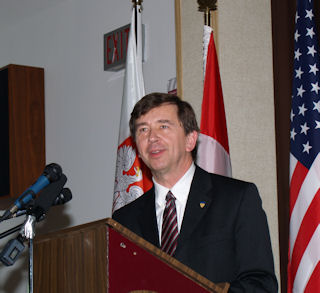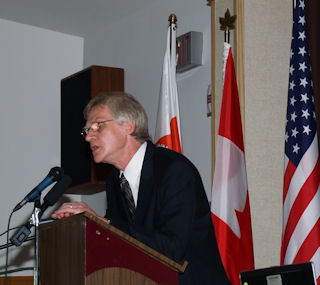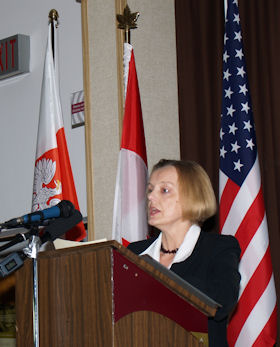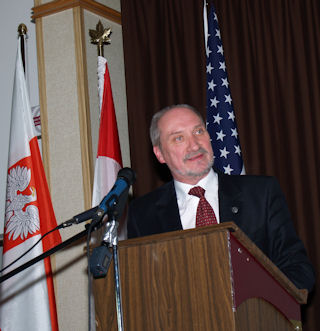
Breaking
news: "Polish Governmental Plane did not crash as previously
reported!"

On February 3, 2012 at Saint Paul University in Ottawa an expert panel presented findings from an investigation into the crash of the Polish Governmental Plane. The fatal crash of the Polish Air Force Tupolev TU-154M occurred on April 10, 2010 in Smolensk, Russia. On board were 96 prominent figures from Polish political and public elites, and NATO military.
This is an on-going investigation carried out by the Polish Parliamentary Commission led by Antoni Macierewicz, relying on international experts from USA, Poland, Russia and other countries. The investigation is conducted independently of the two official investigations by the Russian and Polish authorities. The official Russian investigation concluded that the crash was caused by pilots’ error and a collision with a birch tree. Final report issued by the Polish authorities is a mere rubber stamp copy of the Russian report. In fact, Macierewicz investigation is checking the validity of the official reports and their conclusions.
Since the first moments after the crash, Russian authorities have been destroying and manipulating vital evidence with a blind approval from the Polish government ( click to see video ). The plane wreckage and the original black boxes with recordings of the last minutes of the fatal flight have been withheld by Russia. Forensic autopsies have not been performed, because access to the bodies of the victims had been denied.
The investigators and experts gathered in Ottawa to present their research and findings, which discredit the official reports as false and scientifically invalid.
 Professor Wieslaw Binienda,
Chairman of the Civil Engineering Department at the University of
Akron, Ohio and expert of NASA/Federal Aviation Administration,
studied if the birch tree could have broken the wing of the Tu-154
aircraft. He applied the cutting edge NASA aerospace methodology and
computing programs. Scientific simulations proved that regardless of
the scenario for the contact between the wing and the birch tree, and
birch diameter and its density, the wing cut through the birch,
without losing its lifting capabilities
( click to see video ).
His research debunks Russian
statements that the piece of the wing, sheared off by the birch at an
altitude of 6.5 meters, travelled a distance of 111 meters, through a
forested area, before hitting the ground. He determined that this
piece could only travel a distance of up to 12 meters.
Professor Wieslaw Binienda,
Chairman of the Civil Engineering Department at the University of
Akron, Ohio and expert of NASA/Federal Aviation Administration,
studied if the birch tree could have broken the wing of the Tu-154
aircraft. He applied the cutting edge NASA aerospace methodology and
computing programs. Scientific simulations proved that regardless of
the scenario for the contact between the wing and the birch tree, and
birch diameter and its density, the wing cut through the birch,
without losing its lifting capabilities
( click to see video ).
His research debunks Russian
statements that the piece of the wing, sheared off by the birch at an
altitude of 6.5 meters, travelled a distance of 111 meters, through a
forested area, before hitting the ground. He determined that this
piece could only travel a distance of up to 12 meters.
He also proved that, in fact, the aircraft wing has never made contact with the birch tree. The wing was most probably ruptured at 69 meters past the location of the birch tree, and at an altitude of 26 meters, over 14 meters above the local tree line. ( click to see map of the terrain and plane's trajectories )
 Professor Kazimierz Nowaczyk
from the Center of Fluorescence Spectroscopy at the University of
Maryland analyzed the Terrain Awareness and Warning System (TAWS) and
the Flight Management System (FMS) logs. These instruments were made
in USA. Russian side asked Americans to do the readout of the
recorded data. Americans provided Macierewicz Commission with a copy
of the logs. Nowaczyk proved that the aircraft did not change its
course until 140 meters after passing the birch tree. This
contradicts the official reports that the aircraft after losing one
third of the left wing while hitting the birch tree, turned to the
left, ascend, and rolled over crashing to the ground. It is
physically impossible for the plane that is missing a part of a wing
to ascend. It is also impossible for a plane with the wing span of 38
meters to roll over at an altitude of 6.5 meters, where the birch was
cut.
Professor Kazimierz Nowaczyk
from the Center of Fluorescence Spectroscopy at the University of
Maryland analyzed the Terrain Awareness and Warning System (TAWS) and
the Flight Management System (FMS) logs. These instruments were made
in USA. Russian side asked Americans to do the readout of the
recorded data. Americans provided Macierewicz Commission with a copy
of the logs. Nowaczyk proved that the aircraft did not change its
course until 140 meters after passing the birch tree. This
contradicts the official reports that the aircraft after losing one
third of the left wing while hitting the birch tree, turned to the
left, ascend, and rolled over crashing to the ground. It is
physically impossible for the plane that is missing a part of a wing
to ascend. It is also impossible for a plane with the wing span of 38
meters to roll over at an altitude of 6.5 meters, where the birch was
cut.
Professor Nowaczyk determined that the two unusually strong shocks on the aircraft vertical acceleration happened at a distance of 69 meters past the birch tree. This surprisingly corresponds with the results of professor Binienda’s independent research that most probably the wing separated at the same distance.
 Attorney
Maria Szonert-Binienda debunked the main conclusions of the official
reports. The decision to clear the Tu-154M airplane to the minimum
descent altitude of 100 meters was made by Russian Colonel
Krasnokutski, an unauthorized person at the Smolensk Severny Air
Traffic Control Tower, as evidenced by Appendix 8 to the Polish
government report (Miller’s Report). The analysis of copies of
the black box recordings, conducted by the J. Sehn Institute
of Forensic Research in Cracow, Poland, proves that the pilots
correctly planned and executed the "Go Around" maneuver.
The reading of the Cockpit Voice Recorder proves that the pilot in
command did not intend to "land at any means." Finally,
there is no evidence of any pressure exerted on the pilot to "land
at any means" by the Commander-in-Chief of the Polish Air Force
and Polish President.
Attorney
Maria Szonert-Binienda debunked the main conclusions of the official
reports. The decision to clear the Tu-154M airplane to the minimum
descent altitude of 100 meters was made by Russian Colonel
Krasnokutski, an unauthorized person at the Smolensk Severny Air
Traffic Control Tower, as evidenced by Appendix 8 to the Polish
government report (Miller’s Report). The analysis of copies of
the black box recordings, conducted by the J. Sehn Institute
of Forensic Research in Cracow, Poland, proves that the pilots
correctly planned and executed the "Go Around" maneuver.
The reading of the Cockpit Voice Recorder proves that the pilot in
command did not intend to "land at any means." Finally,
there is no evidence of any pressure exerted on the pilot to "land
at any means" by the Commander-in-Chief of the Polish Air Force
and Polish President.
 Antoni Macierewicz, Chairman of
the Parliamentary Commission, explained how the Russian government
manipulated and adopted civil procedures to investigate this military
flight. This legal gimmick deprives the Polish opposition from
seeking recourse with the International Civil Aviation Organization.
He also alluded to a difficult political situation in Poland, where
scientists are afraid to openly support his investigation as they
fear for their lives and their careers. There have also been
suspicious deaths of experts and witnesses.
Antoni Macierewicz, Chairman of
the Parliamentary Commission, explained how the Russian government
manipulated and adopted civil procedures to investigate this military
flight. This legal gimmick deprives the Polish opposition from
seeking recourse with the International Civil Aviation Organization.
He also alluded to a difficult political situation in Poland, where
scientists are afraid to openly support his investigation as they
fear for their lives and their careers. There have also been
suspicious deaths of experts and witnesses.
Macierewicz called for an independent international inquiry to find out the real cause of the crash, and to compel Russians to return the vital evidence. He asked the Canadian public for support, and to pressure politicians to help establish such an inquiry.
There was a lot of interest and there were many questions from the floor, public figures, and Canadian aviation experts (an investigator of air catastrophes, an ex-military pilot familiar with the Tupolev aircraft, and a VIP pilot), who offered their expertise to help this inquiry.
Solidarity 2010 – Ottawa
More information available at http://www.solidarnosc2010.com/news/eng/smolensk.htm
info@solidarnosc2010.com UNANSWERED QUESTIONS: Crash of the Polish government plane TU-154M Viedo recording of the presentations. Upon completion of the particular part click on the link to the next one to continue.
UNANSWERED QUESTIONS: Crash of the Polish government plane TU-154M Viedo recording of the presentations. Upon completion of the particular part click on the link to the next one to continue.
 The Crash to be Investigated (PDF file) Press information released by the organizers after panel discussion: the Association of Polish Engineers in Canada, Ottawa Branch
The Crash to be Investigated (PDF file) Press information released by the organizers after panel discussion: the Association of Polish Engineers in Canada, Ottawa Branch UNANSWERED QUESTIONS: Crash of the Polish government plane TU-154M More information about the public presentations and panel discussion organized by the Association of Polish Engineers in Canada, Ottawa Branch
UNANSWERED QUESTIONS: Crash of the Polish government plane TU-154M More information about the public presentations and panel discussion organized by the Association of Polish Engineers in Canada, Ottawa Branch April 2010 crash of Polish Air Force One TU-154 in Smolensk, Russia - Youtube video Video shows how Russians destroyed evidence. Read description on the Youtube, check posted links.
April 2010 crash of Polish Air Force One TU-154 in Smolensk, Russia - Youtube video Video shows how Russians destroyed evidence. Read description on the Youtube, check posted links.
 Wieslaw Binienda: Analysis of the Polish Governmental Plane Crash in Smolensk, Russia, on April 10, 2010, Status Report on Smolensk Crash (PDF file)
Wieslaw Binienda: Analysis of the Polish Governmental Plane Crash in Smolensk, Russia, on April 10, 2010, Status Report on Smolensk Crash (PDF file)
 Smolensk disaster was not an accident
Leszek Misiak and Grzegorz Wierzcholowski talk to Antoni Macierewicz, leader of Parliamentary Team for Investigating Causes of Tu-154M Catastrophe on April 10th, 2010.
Smolensk disaster was not an accident
Leszek Misiak and Grzegorz Wierzcholowski talk to Antoni Macierewicz, leader of Parliamentary Team for Investigating Causes of Tu-154M Catastrophe on April 10th, 2010. Polish President's Plane Crash Analysis "Russian Image Management" By Eugene Poteat a retired senior CIA officer,
Tomasz Sakiewicz, the Editor in Chief of Polandís leading opposition newspaper "Gazeta Polska", goes on record: "The Polish president [Lech Kaczynski] was murdered!", What they said about Polish President's Plane Crash..., List of passengers on Polish plane.
Polish President's Plane Crash Analysis "Russian Image Management" By Eugene Poteat a retired senior CIA officer,
Tomasz Sakiewicz, the Editor in Chief of Polandís leading opposition newspaper "Gazeta Polska", goes on record: "The Polish president [Lech Kaczynski] was murdered!", What they said about Polish President's Plane Crash..., List of passengers on Polish plane.
 "The Death of a President": A detailed chronology of events leading to the death of President of Poland, Lech Kaczynski, and Polish Government Delegation near Smolensk, Russia, on April 10, 2010, and its aftermath ...
"The Death of a President": A detailed chronology of events leading to the death of President of Poland, Lech Kaczynski, and Polish Government Delegation near Smolensk, Russia, on April 10, 2010, and its aftermath ...
 Freedom and Truth Undelievred speech prepared by Lech Kaczynski, the President of Poland, for the celebrations scheduled for 10th April 2010
Freedom and Truth Undelievred speech prepared by Lech Kaczynski, the President of Poland, for the celebrations scheduled for 10th April 2010
 Evidence: Tragic Polish Flight Was No Accident - A Retired CIA Officer Makes His Case (Charleston Mercury)
Evidence: Tragic Polish Flight Was No Accident - A Retired CIA Officer Makes His Case (Charleston Mercury)
 Suspicious Circumstances Surround Kaczynski Plane Crash (The American Mercury)
Suspicious Circumstances Surround Kaczynski Plane Crash (The American Mercury)